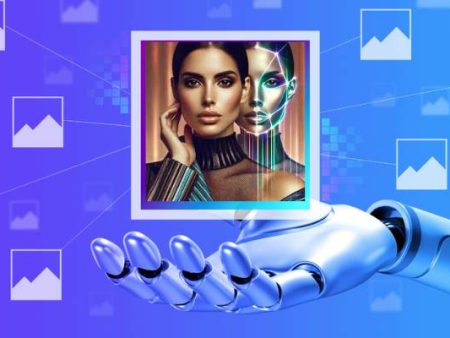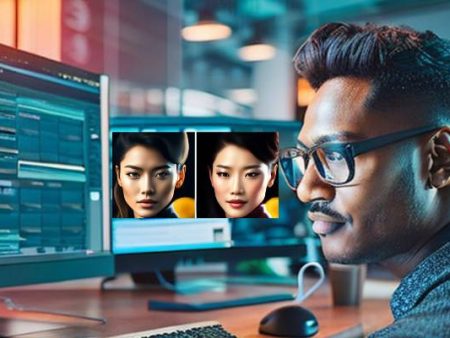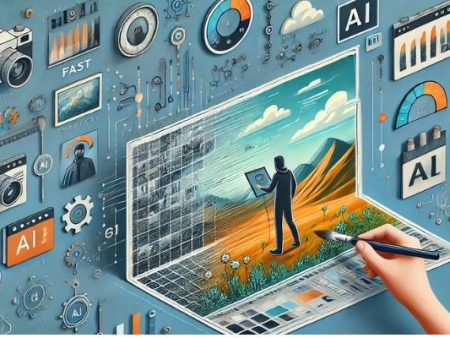Not too long ago, if you asked a business owner or an agency who they needed to make their vision real, the answer was straightforward: a graphic designer.
Someone who could take rough ideas, messy notes, and wild dreams and translate them into visuals.
But now the conversation has shifted. Walk into creative communities online, and you’ll hear a very different kind of question: Do we still need designers if AI image generators can do the job in seconds?
It’s not just idle speculation. AI tools are popping up in advertising, gaming, marketing, and fashion.
They’re not just speeding up design work; they’re reshaping what “design work” even means. But does that mean they’re about to replace graphic designers altogether? Or is the story more complicated?
That’s what this article will unpack—both the threat and the opportunity.
The Arrival of AI Image Generators
First, a quick reality check. How role of AI image works is both fascinating and unsettling.
AI image generators are trained on billions of visuals—photographs, digital art, designs, illustrations—absorbing patterns of composition, color, style, and form.
When you type a prompt—“a minimalist poster of a mountain landscape at sunrise in Japanese woodblock style”—the AI translates that language into pixels.
The results? Often stunning. Sometimes flawed. But undeniably fast. What once took hours or even days of painstaking design can now be produced in under a minute.
For businesses, that’s incredibly attractive. For designers, it’s nerve-wracking.
Why Businesses Are Tempted
Let’s not pretend companies don’t notice. AI offers them three things graphic design rarely does:
- Speed: A hundred variations in seconds.
- Cost savings: No hourly rates, no revision cycles, no overhead.
- Scalability: From social media banners to concept art, AI doesn’t get tired.
This is where the tension begins. Because if a marketing manager can get decent results instantly, why wait for a designer to go through rounds of brainstorming and drafts?
But here’s the flaw in that thinking: “decent” isn’t always enough.
The Designer’s Edge: Beyond Pretty Pictures
Graphic design isn’t just about making things look good. It’s about making things work. A logo, for example, isn’t just shapes and colors—it’s identity, brand memory, cultural context.
An AI can generate a thousand logos in a second, but can it understand how a design will resonate with a specific audience, in a specific culture, at a specific moment in history? Not really.
Designers bring more than visuals—they bring insight, empathy, strategy. They ask: What story are we telling? What feelings are we evoking?
What subconscious signals are we sending? That’s where human creativity still holds power.
Issues With Real Than Real Photos
But let’s be honest—AI does have an unnerving strength. Sometimes, it creates visuals that look issues with real than real photos.
Think about portraits. Studies have shown people often rate AI-generated faces as more realistic and trustworthy than photographs of actual humans (PNAS study, 2022). That’s not just impressive—it’s disorienting.
When AI can produce images that feel more “real” than reality itself, it challenges how audiences perceive authenticity.
And if brands decide customers respond better to AI portraits than real photography, that’s a challenge graphic designers and photographers will have to face head-on.
How AI Tools Are Redefining Works
So where exactly do designers fit in this landscape? The truth is, how AI tools are redefining works is by shifting what we expect designers to do.
Instead of spending hours adjusting typography kerning or manually cutting backgrounds, designers are now being asked to guide AI outputs, refine them, and integrate them into coherent campaigns.
In other words, their role is evolving from creator to curator. They’re no longer just crafting visuals by hand—they’re directing the tools, steering AI’s raw outputs into meaningful communication.
This doesn’t mean less creativity. If anything, it requires more vision. Because when anyone can type in a prompt and generate an image, the real differentiator becomes taste, strategy, and conceptual clarity.
The Fashion Parallel: Issues With Models to AI-Designed Outfits
Fashion has become a revealing case study. Some brands are experimenting with AI-generated models wearing virtual clothing. The issues with models to AI-designed outfits are complex.
On one hand, this innovation saves costs. Brands no longer need to pay for photoshoots, travel, or stylists. They can generate dozens of looks digitally and market them instantly.
On the other hand, real models—their presence, personalities, and individuality—are irreplaceable for storytelling.
An AI avatar may look flawless, but it lacks charisma, the subtle quirks that make a model memorable.
For designers, this parallels their own situation. AI may produce “perfect” graphics. But perfection isn’t always connection.
Sometimes the little imperfections—the human fingerprint—are what make a brand feel relatable.
The Emotional Side: Designers Under Pressure
It’s easy to talk about this in cold business terms, but let’s not forget the emotional toll.
Many designers I’ve spoken with feel not just threatened but disheartened. They’ve spent years honing skills, only to see algorithms mimic them in seconds. It feels unfair, even demeaning.
But at the same time, some designers also feel liberated. AI takes over the boring parts—resizing assets, generating mockups—freeing them to focus on higher-level creativity.
It’s a double-edged sword, and how a designer reacts depends on whether they see AI as a competitor or a collaborator.
Market Data: A Reality Check
The numbers paint a complicated picture.
- The AI image generation market is projected to reach $63 billion by 2028, growing at nearly 30% annually (MarketsandMarkets).
- Meanwhile, the graphic design services industry in the U.S. was valued at $13.3 billion in 2023, but growth is slow—around 3% annually (IBISWorld).
These figures suggest AI is expanding far faster than traditional design, but they don’t mean design jobs will disappear overnight. Instead, roles may shift dramatically.
Case Studies: Designers Using AI Well
Let’s flip the perspective for a moment. Some designers are thriving precisely because they’ve embraced AI.
- Agencies: Creative agencies use AI to generate dozens of concept variations, narrowing down ideas before refining the best ones manually.
- Freelancers: Independent designers use AI tools to speed up workflows, offering faster turnaround times for clients.
- Artists: Some illustrators collaborate with AI to create hybrid works that combine digital brushwork with algorithmic textures.
The takeaway? Designers who adopt AI as part of their toolkit may actually become more valuable—not less.
The Ethical Angle
Of course, the ethics of AI can’t be ignored. Many image generators are trained on existing art, raising questions about copyright and exploitation.
Graphic designers have a right to be angry when their work is used without permission to train tools that then compete against them.
This conversation is far from over. Governments and industry leaders will need to step in with regulation, and designers themselves will need to advocate for fair treatment.
So, Will AI Replace Designers?
Here’s my honest opinion: AI won’t replace graphic designers outright, but it will replace bad or generic design.
The professionals who survive and thrive will be the ones who:
- Use AI as a tool, not a rival.
- Focus on storytelling, strategy, and emotional resonance.
- Lean into human intuition and cultural nuance—the things machines can’t replicate.
In other words, AI may replace tasks, but not talent.
Conclusion: A Redefinition, Not an Extinction
So, why could AI replace designers—or not?
Because in some ways, it already has. Basic design tasks, quick graphics, repetitive layouts—AI can do those instantly.
But in other ways, it never will. The deep empathy, the nuanced storytelling, the ability to sense cultural moments—those belong to human designers.
What’s happening now isn’t extinction. It’s redefinition. Designers are becoming directors, strategists, curators of meaning. Their canvas has changed, but their value hasn’t disappeared.
The bigger challenge isn’t whether AI can make art. It’s whether we, as humans, will continue to value the messy, imperfect, soulful touch of human creativity in a world that increasingly demands speed and efficiency.
And for me, I hope we do. Because even if AI can create real than real photos, design isn’t just about realism—it’s about resonance. And that, at least for now, remains beautifully human.


